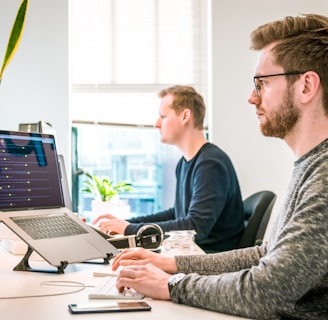How to Improve Posture While Working from Home: A Complete Guide


How to Improve Posture While Working from Home: A Complete Guide
Welcome, fellow remote workers! If you're reading this, chances are you've caught yourself hunched over your laptop like a modern-day Quasimodo, or your back is sending you more distress signals than a submarine with a screen door. Fear not! This guide is here to transform you from a work-from-home gargoyle into the epitome of ergonomic elegance. Let's dive into the world of proper posture, where the only thing we're bending is the rules of traditional office setups.
Table of Contents
Understanding Good Posture: More Than Just Sitting Up Straight
When to Seek Professional Help: Because Sometimes, You Need a Pro
Introduction: The Posture Pandemic
Welcome to the era of remote work, where our homes have become our offices, our dining tables are our desks, and our posture... well, let's just say it's seen better days. As we navigate this brave new world of virtual meetings and pajama-clad productivity, we've unwittingly become participants in what can only be described as a global posture pandemic.
But fear not, intrepid home worker! This guide is your vaccine against the slouch, your booster shot of ergonomic enlightenment. We're here to transform your work-from-home experience from a pain in the neck (literally) to a beacon of spinal sophistication.
A study published in the International Journal of Environmental Research and Public Health found that 41.2% of people reported experiencing lower back pain while working from home. If you're part of this statistic, consider yourself officially drafted into the posture improvement army. Your mission, should you choose to accept it (and really, your spine insists that you do), is to emerge from this guide standing taller, sitting straighter, and working smarter.
So, straighten up (but not too much, we'll get to that), and let's embark on this journey to posture perfection. Your back will thank you, your neck will praise you, and who knows? You might even gain an inch or two in height. Posture improvement: the only "get taller quick" scheme that actually works!
Understanding Good Posture: More Than Just Sitting Up Straight
Ah, posture. That thing your grandmother always nagged you about, right between "eat your vegetables" and "don't sit too close to the TV." But what exactly is good posture, and why does it matter more than ever in our work-from-home world?
Good posture isn't about sitting ramrod straight like you're auditioning for a part in "The Nutcracker." It's about maintaining the natural curves of your spine in a position that puts the least amount of strain on your supporting muscles and ligaments. Think of it as finding your spine's happy place.
Here's what good seated posture looks like:
Your feet are flat on the floor (or on a footrest if you're vertically challenged)
Your knees are at or below hip level
Your back is supported, with your buttocks touching the back of your chair
Your shoulders are relaxed, not hunched or rounded
Your arms rest comfortably on your desk or chair armrests
Your computer screen is at eye level, so you're not craning your neck like a curious giraffe
Now, why does this matter? Well, apart from making you look like you've got your life together (even if your laundry pile suggests otherwise), good posture has some serious benefits. A study in the journal Health Psychology found that people who sat up straight reported feeling more confident and had higher self-esteem. So, not only will good posture make you feel better physically, but it might also give you the confidence to finally ask for that raise. Win-win!
But wait, there's more! Proper posture can:
Reduce back and neck pain (goodbye, ibuprofen dependency!)
Improve breathing (because who doesn't want more oxygen?)
Enhance core and scapular strength (hello, incidental workout!)
Increase energy levels (move over, coffee... actually, nevermind, stay right there)
So, the next time you catch yourself slouching, imagine your spine throwing a tiny tantrum. Give it what it wants - good alignment - and enjoy the benefits of being posture-perfect.
The Home Office Setup: Your Throne Awaits
Welcome to MTV Cribs: Home Office Edition! Today, we're turning your workspace from a ergonomic nightmare into a throne room fit for royalty (or at least someone who cares about their lumbar support).
First things first, let's talk about your chair. This isn't just a place to park your posterior; it's the throne upon which you'll rule your remote work kingdom. Look for a chair with adjustable height, good lumbar support, and armrests. If your chair were a significant other, it should be supportive, flexible, and always have your back.
Next up, your desk. The ideal desk height is when your elbows are at a 90-degree angle while typing. If your desk is too high, you might end up with your shoulders closer to your ears than a stressed-out cartoon character. Too low, and you'll be doing your best Hunchback of Notre Dame impression.
Now, let's address the elephant in the room - or rather, the screen on your desk. Your monitor should be at eye level, about an arm's length away. If you're using a laptop, invest in a separate keyboard and mouse, and prop that laptop up on some books. Think of it as giving your laptop a stage to perform on, while you sit back and enjoy the show.
Speaking of keyboards, position yours so your wrists are straight and your arms are close to your body. Your mouse should be right next to your keyboard, not playing hard to get at the far corner of your desk.
Lighting is crucial too. You want to avoid glare on your screen, unless you're going for that "squinting at the sun" look. Natural light is great, but if your home office is more "dark cave" than "sun-drenched loft," invest in some good task lighting.
Finally, don't forget about your feet! They should be flat on the floor. If you're vertically challenged (like yours truly), use a footrest. Your feet will thank you for not leaving them dangling like forgotten participles.
Remember, Rome wasn't built in a day, and neither is the perfect home office. But with these tips, you're well on your way to creating a workspace that's so ergonomically correct, it would make a chiropractor weep with joy.
Ergonomic Equipment: Investing in Your Spine's Future
Alright, it's time to talk about everyone's favorite topic: spending money on things that aren't nearly as fun as a new TV or a vacation, but are arguably more important for your long-term health and comfort. Welcome to the thrilling world of ergonomic equipment!
First up, let's discuss ergonomic chairs. A good ergonomic chair is like a supportive best friend – it's got your back, keeps you grounded, and helps you maintain a good position in life. Look for features like adjustable lumbar support, seat depth, and armrests. And remember, the best chair is the one that fits YOU. One person's ergonomic dream could be another's backache nightmare.
Next, consider a standing desk. These nifty contraptions allow you to alternate between sitting and standing throughout the day, like a workplace version of musical chairs (minus the music, and the panic when the song stops). A study published in the International Journal of Environmental Research and Public Health found that using a sit-stand desk reduced upper back and neck pain by 54% compared to sitting all day. That's right, you could potentially halve your "Why does my neck feel like it's been replaced by a rusty hinge?" complaints!
But wait, there's more! Let's not forget about ergonomic keyboards and mice. These are designed to keep your wrists in a more natural position, reducing the risk of repetitive strain injuries. It's like yoga for your hands, minus the om-ing and the risk of falling over during downward dog.
For the laptop users out there (and let's face it, that's most of us), consider a laptop stand. This elevates your screen to eye level, preventing you from permanently adopting the "tech neck" pose. Pair it with a separate keyboard and mouse, and you've got yourself a setup that would make an ergonomist swoon.
Don't forget about your feet! A footrest can help maintain proper posture and improve circulation. It's like a mini vacation for your feet, minus the sandy beaches and coconut drinks.
Lastly, if you really want to go all out, there are things like ergonomic seat cushions, lumbar support pillows, and even balance boards for standing desks. It's like building your own ergonomic theme park, where the only rides are comfortable and good for your health.
Remember, investing in ergonomic equipment is investing in your future self. Your spine will thank you, your neck will praise you, and your future medical bills might just be a little bit lower. Now that's what I call a return on investment!
Posture-Improving Exercises: Becoming a Desk Athlete
Welcome to the gym, desk jockeys! Today, we're going to turn your office chair into a piece of exercise equipment. No, we're not suggesting you start bench-pressing your filing cabinet (although, if you can, color us impressed). We're talking about exercises you can do right at your desk to improve your posture and become the Olympic athlete of sitting.
First up, let's talk about the "Shoulder Blade Squeeze." Sit up straight, then squeeze your shoulder blades together as if you're trying to hold a pencil between them. Hold for 5-10 seconds, then release. Repeat this 10-15 times. It's like a hug for your back muscles, minus the awkward social interaction.
Next, we have the "Chin Tuck." This one's simple: sit up straight, then gently tuck your chin down and back, as if you're trying to make a double chin (finally, a good use for that!). Hold for 5 seconds, then release. Repeat 10 times. This exercise helps counteract the forward head posture we often develop from staring at screens all day.
For our core, we have the "Seated Ab Crunch." Sit on the edge of your chair, hands on the armrests. Engage your abs and lift your feet off the floor, bringing your knees toward your chest. Lower and repeat 15-20 times. It's like doing crunches, but with the added challenge of trying not to roll your chair across the room.
Don't forget about your legs! Try the "Desk Squat." Stand up from your chair, then lower yourself down until you're almost sitting, but not quite. Hold for 5 seconds, then stand back up. Repeat 10-15 times. It's like playing an endless game of "musical chairs" with yourself.
Lastly, we have the "Desk Plank." Place your forearms on your desk, walk your feet back until your body forms a straight line from head to heels. Hold for 20-30 seconds. It's like a regular plank, but with the added bonus of looking extremely odd to anyone who walks in on you.
A study published in the Journal of Physical Therapy Science found that office workers who performed strengthening exercises experienced significant improvements in their posture and reduction in neck pain. So, not only will these exercises make you feel better, but they're scientifically proven to help!
Remember, the key to becoming a desk athlete is consistency. Try to do these exercises a few times throughout your workday. Before you know it, you'll be the Michael Phelps of sitting, the Usain Bolt of good posture, the Simone Biles of... well, you get the idea.
Stretching Routines: Yoga, But Make It Office
Alright, yogis and yoginis of the corporate world, it's time to turn your office into a zen den of flexibility. We're not suggesting you start chanting "Om" in the middle of your Zoom calls (unless that's your thing, in which case, namaste to you), but incorporating some stretches into your day can work wonders for your posture and overall well-being.
Let's start with the "Seated Spinal Twist," the office chair edition of a classic yoga pose. Sit sideways in your chair, feet flat on the floor. Place your right hand on the back of the chair and your left hand on your right knee. Gently twist to the right, using your core muscles. Hold for 15-30 seconds, then switch sides. It's like wringing out your spine like a wet towel, but in a good way.
Next up, we have the "Chair Pigeon Pose." Sitting in your chair, cross your right ankle over your left knee. Gently lean forward, keeping your back straight. You should feel a stretch in your right hip and glute. Hold for 15-30 seconds, then switch sides. It's like the yoga pigeon pose, but with less chance of face-planting.
For your upper body, try the "Desk Downward Dog." Stand up and place your hands on your desk, wider than shoulder-width apart. Step back and bend at the hips, creating an inverted V shape with your body. Press your chest towards your thighs and try to get your heels to the ground. Hold for 15-30 seconds. It's like the yoga version, but your coworkers are less likely to think you've lost your mind.
Don't forget about your neck! The "Neck Release" is simple but effective. Sit up straight, then gently tilt your right ear towards your right shoulder. Hold for 15-30 seconds, then switch sides. It's like your head is trying to whisper a secret to your shoulder, but in a very slow, stretchy way.
Lastly, we have the "Seated Forward Bend." Sit on the edge of your chair with your feet flat on the floor. Slowly bend forward, letting your upper body hang down between your legs. Let your arms dangle towards the floor. Hold for 15-30 seconds. It's like you're trying to check if there's gum under your desk, but for your health.
A study published in the International Journal of Yoga found that office workers who practiced yoga experienced significant improvements in their physical and mental well-being, including better posture and reduced stress levels. So, these aren't just stretches – they're scientifically-backed stress-busters and posture-perfectors!
Remember, the key is to listen to your body. If a stretch doesn't feel right, don't force it. We're aiming for "oh, that feels good" not "oh no, I think I've just turned myself into a human pretzel."
Mindfulness and Posture: The Mind-Spine Connection
Welcome to the zen zone, where we explore the mystical connection between your brain and your backbone. No, we're not about to go all "The Matrix" on you (although, if you could dodge bad posture like Neo dodges bullets, that would be pretty cool). We're talking about mindfulness and how it can be your secret weapon in the battle for better posture.
First things first, let's define mindfulness. It's not just for yoga instructors and meditation gurus. Mindfulness is simply the practice of being aware of the present moment. And when it comes to posture, it's about being aware of your body's position in space. It's like having a built-in posture alarm, minus the annoying beeping.
Start by setting "posture check" reminders throughout your day. When the reminder goes off, take a moment to notice your posture. Are you slouching like a melting snowman? Is your neck craned forward like you're trying





